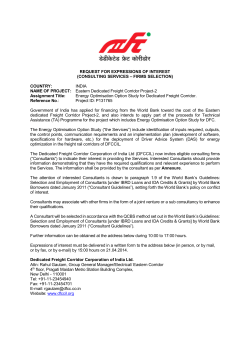
Ton-mile Emissions Factors CO2E Emissions for
U.S. Freight GHG Emissions by Consuming Industry Segment (Paper No. 13-4191) Authors Larry O’Rourke Kelsey Read Eliza Johnston ICF International Laurence.O’Rourke@icfi.com ICF International Kelsey.Read@icfi.com ICF International Elizabeth.Johnston@icfi.com About This Paper This paper estimates GHG emissions from freight transport consumed by U.S. industries. GHG emissions are allocated to detailed industry sectors. The methodology described here uses ton-mile estimates by mode and commodity, allocates these ton-mile flows to producing industries in the U.S. Input-Output Tables and estimates the consuming industries based on the relationships in the I-O table. GHG emissions are estimated using ton-mile emission factors. The results provide detailed data on the consumption of freight services and the energy intensity of these services by industry sector. Introduction Key Data Sources Ton-mile Emissions Factors •Commodity Flow Survey, Bureau of Transportation Statistics & Census Bureau – Average shipment distance by commodity and mode used to estimate ton-miles •Emission factors for truck, rail and domestic air were based on estimates from the EPA Climate Leaders Program. •Vessel Entrances and Clearances Database, U.S. Army Corps of Engineers – Estimate top origin-destination pairs for marine freight moving from international FAF regions and the average shipment distance •T-100 Domestic and International Air Carrier Data, Bureau of Transportation Statistics – Data used to estimate average air shipment distance from FAF foreign regions to U.S. destinations •Transborder Surface Freight Data – Used to estimate average shipment distance of truck and rail shipments between Mexico, Canada and the U.S. •Freight Analysis Framework, FHWA – Used to estimate freight tonnage by commodity & mode for foreign and domestic shipments Freight Analysis Framework 2010 Provisional Database This paper provides an analysis of the industry sector breakdown of GHG emissions from inbound freight transportation in the United States. Much of the research already present in this field examines freight related emissions by mode or by the commodity being shipped. This study augments this research by estimating freight related emissions by ton-mile and assigning them to industry sectors that consume the freight. •TTS marine emissions factors for domestic transport for inland towing were used. •International marine transport emission factors for ocean going vessels are from the U.S. GHG Protocol. •Pipeline emissions were estimated per ton from the U.S. Transportation Greenhouse Gas Inventory, EPA. •Domestic air emissions factors rely on data from the U.S. GHG Inventory. •International air transport emission factor is lower based on the longer average distance for international shipments. •Multimodal emission factors were estimated using a combination of moves by different modes. 1.6 Estimate ton-miles Match the SCTG codes to I-O codes Domestic 1.5427 1.2 International 1.0 Pipeline Ton-Mile Emissions: 0.9272 •All Others (personal consumption expenditures) Water Utilities For Hire Truck •Beverage and Tobacco Product Manufacturing Private Truck Petroleum and Coal Products Manufacturing Rail 30% •Animal Production Multiple Mode and Mail Other and Unknown 20% Pipeline (Tons) Chemical Manufacturing 2% 2% 3% 3% 3% Transportation Equipment Manufacturing Private fixed investment •Nonmetallic Mineral Product Manufacturing Combined Government 11% 3% Food Manufacturing 26.2054 International: 26.2054 0.8 4% 7% 5% 7% •Construction •Chemical Manufacturing •Private fixed investment •Food Manufacturing Construction 0.6 0.2979 0.2979 0.4 0.0254 0.0177 0.0254 0.0163 0 Air •2002 Benchmark Input-Output Accounts – Data on ton-miles shipped by mode for each commodity (from FAF) was matched from SCTG codes to I-O commodity codes. For this step, in many cases multiple I-O codes needed to be combined to match SCTG codes. After matching the SCTG codes to I-O codes, the 2002 Benchmark I-O Use table was used to assign commodity ton-miles to the industry sectors that consumed the freight being transported. •Retail Air Domestic: Truck Rail Marine 0.1254 0.1254 0.2979 0.2979 Multimodal Other CO2E Emissions Share by Mode •Air 0 20,000 40,000 60,000 Emissions Share from International Trade •Many companies have significant control over their inbound supply chain. Businesses have the ability to influence GHG emissions associated with freight transportation through their purchasing decisions. •The data shows which industries have the most potential to have an impact on reducing GHG emissions from freight transportation. Machinery Manufacturing Fabricated Metal Product Manufacturing •The top industries in order of importance are personal consumption expenditures (retail), construction, food manufacturing, combined government, private fixed investment, transportation equipment manufacturing, chemical manufacturing, petroleum and coal products manufacturing, utilities, and nonmetallic mineral product manufacturing. Food Manufacturing 6% 52% Transportation Equipment Manufacturing Utilities 4% Chemical Manufacturing Combined Government •Multiple Mode and Mail 16% Private Fixed Investment Construction •Rail Petroleum and Coal Products Manufacturing Acknowledgement Personal Consumption Expenditures •Private Truck •For Hire Truck •Combined Government Summary Crop Production 6% •Transportation Equipment Manufacturing 80,000 Computer and Electronic Product Manuf. 5% •Other and Unknown Personal Consumption Expenditures Primary Metal Manufacturing 10% 2002 Benchmark Input-Output Accounts •Petroleum and Coal Products Manufacturing Percent Share of CO2E Emissions from International Freight Movement by Industry •Water •Pipeline Use 2002 Benchmark I-O Use table to assign commodity ton-miles to the industry sectors that consumed the freight being transported Translate ton-miles into Kgs of CO2 equivalent emissions Nonmetallic Mineral Product Manufacturing •Utilities 1% Estimate average emissions factors specific to the mode (and in some cases domestic or international shipments) CO2E Emissions Associated with Freight Services Consumed by Industry Sector 1.4 Methodology Estimate the average miles traveled for each commodity CO2E Emissions by Industry Sector 1.8 0.2 Obtain estimates of tons of freight by commodity moved in the U.S. from the Freight Analysis Framework 2010 provisional data CO2E Emissions for Top 10 Industries by Mode – Million Kilograms 0% 10% 20% 30% 40% 50% 60% 70% The research described in this paper was supported by the Environmental Defense Fund.
© Copyright 2025











